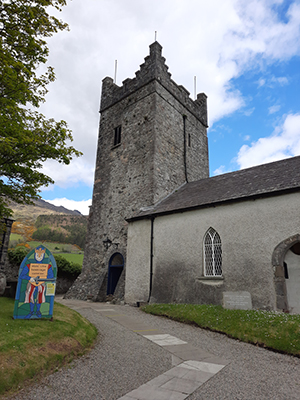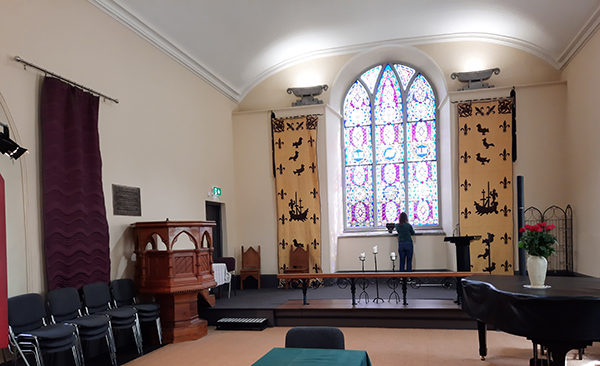Carlingford Heritage Centre
Published in Issue 4 (July/August 2021), Reviews, Volume 29Old Holy Trinity, Carlingford, Co. Louth
info@carlingfordheritagecentre.com
By Tony Canavan

Above: The heritage centre is located in a former Church of Ireland chapel. The nave is eighteenth-century but the church tower is probably medieval.
The seaside town of Carlingford has claims to Viking origins, but the present streetscape reflects an Anglo-Norman foundation, as evidenced by King John’s Castle, which towers over the town. The heritage centre is located in a former Church of Ireland chapel and you get an immediate sense of history as you approach it through the old graveyard, with some of its graves dating back to the seventeenth century. The nave is eighteenth-century, but the church tower is probably medieval. The location has all the indications of having been a motte and bailey, and the medieval tower probably served a military purpose, as at one time Carlingford was the northernmost outpost of the Pale, surrounded by a hostile Gaelic population.
The heritage centre at first glance may seem a modest affair, and Covid-19 restrictions make it look bare, but good use is made of the space. That is true in every sense, as the building not only houses a history exhibition but is also a venue for events from concerts to weddings. There has been no attempt to disguise that this was once the nave of a church, as the basic structure is intact and the stained-glass windows are unaltered. Even the pulpit remains in place. The exhibition is built around seven display cabinets attached to the walls (which can be shuttered if an event is taking place), although the visitor would be advised to start at the television screen, which shows a video introducing the modern town and its heritage.

Above: Skeletal remains found under the floor.
The seven cabinets cover different aspects of Carlingford’s history, a kind of ‘Seven Ages of Carlingford’. They cover topics such as ‘Sovereigns and Burgesses’, ‘Merchants and Mariners’ and ‘Friars and Vicars’. Each cabinet contains information panels, reproductions of documents, maps and photographs. You learn that Carlingford is an Anglo-Norman town which once contained burgage plots, courts and markets. Further on you can see a medieval street plan of Carlingford, showing that it originally consisted of a number of houses of various sizes stretching between King John’s Castle to the north and what is now the heritage centre to the south. You will also discover that Carlingford still has a number of surviving ‘castles’. One, known as the Tholsel, is in fact the last surviving gate from the old town wall, and the others are tower-houses. At this point in your circumnavigation of the building, it is worthwhile to stop and look back at the way you came in. You will see that the back wall is covered with a large mural which gives a bird’s-eye view from the sea, clearly illustrating what the town would have looked like when it was a thriving medieval port.
At the top left-hand corner of the mural is the Dominican friary, established on the outskirts of the town in the early fourteenth century. One display cabinet is dedicated to the religious history of the town, from the arrival of the Dominicans to the establishment of the Church of Ireland. The Dominican friary and its monks were an important influence on the town until they were expelled at the time of the Reformation. The building was converted for secular use before being abandoned in the eighteenth century. A nineteenth-century painting shows extensive remains of the original friary and associated buildings, including a watermill, which is marked on medieval maps.
The focus then shifts to the Church of Ireland and another cabinet tells the history of ‘The Holy Trinity Church’ before it became a heritage centre. We know that a church was on this site for hundreds of years because during twentieth-century renovation works skeletons were discovered under the floor. Radiocarbon dating assigned them to two historical periods, 1442–1650 and 1517–1666. Although the original burials were disturbed and the skeletons broken up during the eighteenth-century renovation works, archaeologists reckon that there are about 22 in situ burials under the floor of the nave. Interestingly, one of the skull fragments found there shows evidence of trepanning, an ancient medical technique that involved drilling a small hole in the skull. The old church building was extensively altered in the eighteenth century, giving it its present appearance. There are some examples of written records relating to the building in this era, mentioning payments for building works, the fees charged for burials and so on.

Above: There has been no attempt to disguise that this was once the nave of a church. Note the stained-glass window and the pulpit (to the left).

Above: A large mural gives a bird’s-eye view from the sea, illustrating what the town would have looked like when it was a thriving medieval port. At the top left-hand corner is the Dominican friary, established on the outskirts of the town in the early fourteenth century. (All images: Carlingford Heritage Centre)
The heritage centre is worth a visit in its own right but also serves as an introduction to the town itself. After a visit to the centre, you will walk along Carlingford’s streets with a greater understanding of its medieval streetscape and a better appreciation of its historic buildings, such as the Mint, Taaffe’s Castle and the Tholsel. After years of archaeological excavation and conservation work, the massive King John’s Castle is once again open to the public, with guided tours available, and it is also well worth a visit.
Tony Canavan is Consultant Editor of Books Ireland.
















